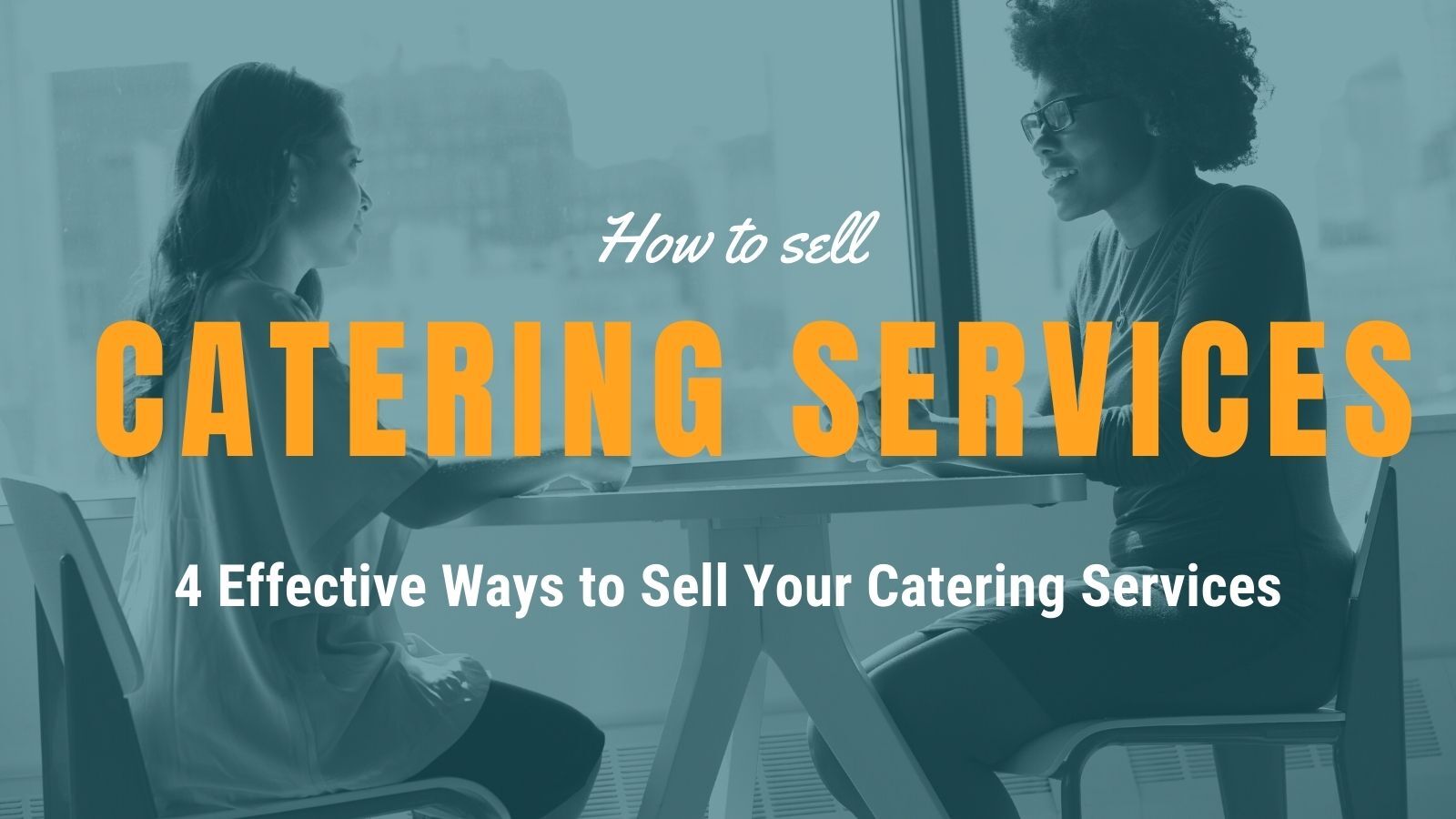Ever since Sarah was a kid, she always had a passion for cooking
In fact, she nursed the idea of being one of the world’s biggest caterers.
Eventually, after completing high school, she decided to follow her passion. So she started a small-scale catering business in her neighborhood in New Jersey.
Her food tasted so great she was constantly getting orders. Also, Sarah has a great personality. So her customers usually experience amazing customer service whenever they order from her.
However, you know one thing Sarah never liked?
One that almost proved detrimental to her business?
Selling.
That’s right. Sarah hated the idea of selling her catering services to people. She relied on the taste of her food and referrals to get customers – a recipe for failure.
And as her competitors grew, her customers reduced. She wasn’t getting orders like before.
Can you see where I’m going with this?
While having a passion for catering is good, it’s not going to pay your bills.
As a drop-off caterer, if you want to sustain and grow your business, then you need to learn how to market your catering business.
Not sure how?
Well, that’s what you’ll discover in this article – how to sell your catering services. But first, you can’t talk about sales without identifying your target market.
How to Identify Your Target Market
Before selling your catering services, it’s essential to know who you are selling to – the ideal target market.
Your target market is a set of individuals who share similar needs or characteristics that you hope to serve.
Identifying these sets of individuals helps you develop effective marketing communication strategies.
This way, you can tailor your content, creative, and message specifically to people who are interested in your services.
And how do you identify your target market?
First, start by clearly defining the kind of catering services you offer. Do you cater to:
- Corporate events (cocktail parties, banquets, office parties, executive luncheons, golf outings, award ceremonies)
- Weddings
- Funerals
- Kids parties
- Adult parties (anniversaries, bachelorette, birthdays, holiday, dinner parties)
- Festivals, concerts, or sports events
- Specific cultures (Like South Asian Cuisines, weddings or parties)
- Type of food (Grazing platters, southern cooking, vegetarian)
Then define the person or business that will want to use your services. Once you have identified your target market, you can craft messages that appeal directly to them.
For example, the kind of message you’ll craft to get wedding clients is different from the one for funerals or corporate events.
On a side note, except if you are a large-scale catering company, it’s advisable to carve a niche for yourself in the catering industry. This way, it’s easier to stand out among your competitors.
Now that you know how to identify your target market, let’s take a look at how to sell your catering services to them.
4 Effective Ways to Sell Your Catering Services
1. Social Media Marketing
In today’s world, Social Media is something most people can’t live without. No wonder there are over 4.2 billion active social media users worldwide.
However, social media started in the 90s as a platform for users to connect digitally with friends, colleagues, family members, and like-minded individuals, most of whom they’ve never met.
Now, social media platforms have grown beyond just a platform for connecting. It has become a source of revenue for lots of businesses around the world.
Social media platforms have a “business” side where companies can run targeted ads to create awareness, reach more people, and generate leads within a specific location.
This makes social media marketing an effective way to market your catering business.
Right now, Facebook and Instagram (owned by Facebook) are two of the leading social media platforms you can use to market your catering services.
But here’s something important you should know:
If you are promoting catering services to a cold audience – people who have never seen or heard of your business before – don’t try to sell to them immediately.
Here’s why:
Firstly, most Facebook and Instagram users go on Facebook to connect. They are not ready to buy. As such, trying to immediately sell to them will result in wasted ads budget.
Secondly, people only buy from people they know, like, and trust. If they don’t know you, why should they trust you enough to buy from you?
This means your best bet is to run ads to create top of mind awareness. Get them to engage with you by either liking your post or video, leaving a comment, or visiting your website.
Also, you can give something small yet valuable and helpful for free.
For example, if you are a wedding caterer, rather than asking people to patronize your services, you can do a short video about 5 Deadly Mistakes to Avoid When Hiring a Wedding Caterer and promote it on Facebook and Instagram.
Or if you are camera-shy, you can create a small PDF and ask people to download it. Then run ads promoting it to your target market.
By giving them something valuable for free, the law of reciprocity kicks in. They are more likely to patronize you in return.
Also, it’s an opportunity to position yourself as an expert while you build trust with your potential clients. Anyone who gets a great deal of help from you for free is more likely to pay for your services.
For a warm audience – people who have already engaged with your brand – you can promote special weekly or holiday menus, seasonal specials, discount offers, giveaways, etc.
For example, see the way How’s Catering uses Facebook to advertise their buffet promo.
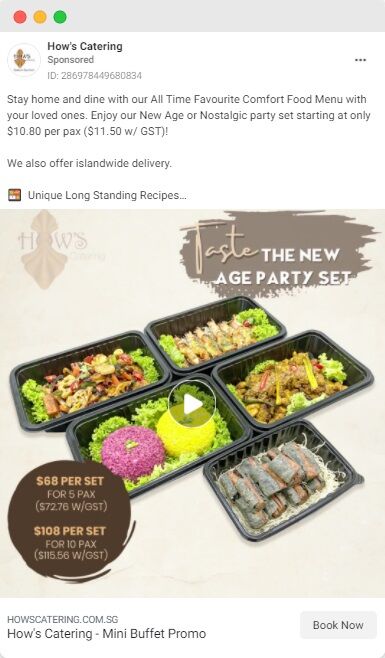
And if you use catering software like HoneyCart to manage your catering business, you can send people from Facebook or Instagram ads straight to your online menu where they can take advantage of your special offers.
If you’d like to learn more about how to run Facebook and Instagram Ads effectively, click here.
2. Pay Per Click (PPC) Advertising
Unlike social media where people go to connect with their family and friends, 53% of US consumers say that they research products using a search engine before deciding whether or not to buy.
However, it can take a lot of time for your website to rank on Google’s first page for keywords related to your catering services. So what’s the fastest way to put your business in front of ready-to-buy customers?
That’s where Google Ads come in.
Google Ads is a platform where business owners bid on specific keywords to appear at the top of Google search results.
This way, potential clients will see your business before your competitors.
Let’s take a look at how it looks in real life:
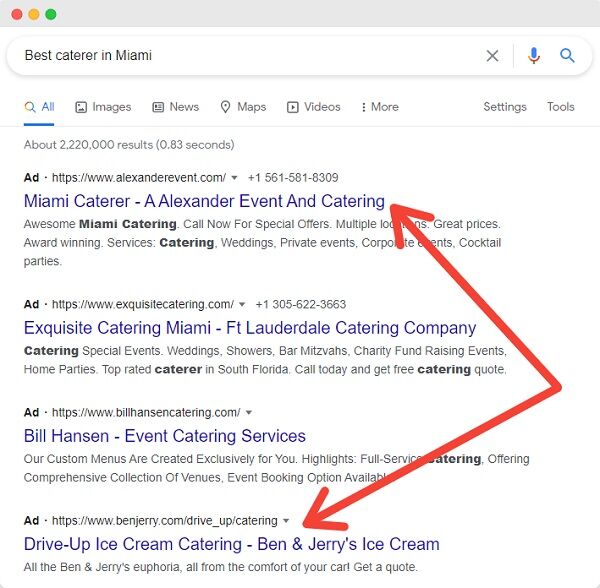
How do you differentiate Google Ads from organic search results? Well, any search result that has “Ad” in its front is a Google Ad.
And as people click your ad, you’ll pay Google a certain amount per click, hence the name Pay Per Click (PPC).
You can use PPC advertising to target keywords related to your catering services. For example, you can run Google ads for:
- Location: “Chicago catering”, “Los Angeles Caterers” “Caterers in Denver”, “best Caterer in Washington”
- Events: “Birthday caterers”, “Wedding catering services”
- Holidays: “Christmas catering services”, “Thanksgiving caterers needed”
- Or a combination: “Wedding caterers in San Diego”, “Family Dinner Caterer in Seattle”, “Corporate catering services in Texas”
The best part about using Google ads to sell more of your catering services is you can target people who are ready to buy now.
When setting up Google ads, you’ll be required to provide a link to your website or online menu.
And that’s where using a commission-free catering automation software like HoneyCart to set up your online menu comes in handy.
Once people click on the link on Google, it takes them straight to your online menu where they can simply place their orders in an instant. This process makes it convenient for them.
And if you provide exceptional service, they will most likely become loyal customers and even refer others to your business.
You can watch this video to learn how to run Google Ads effectively.
3. Email Marketing
Contrary to what you may have heard, email marketing is not dead. It’s still the most effective form of digital marketing.
Email marketing boasts a 4200% ROI. That is, for every one dollar you spend, you’ll get 42$ in return.
This makes email marketing an effective way to sell catering services.
It helps you stay top of your customer’s mind, promote special menus, discount offers, and helpful tips. You can also use it to nurture leads till they become customers.
However, to use email marketing to sell your catering services, you’ll need to have:
- An email list – a list of subscribers who opted in to be part of your newsletters.
- Email marketing software – software to send emails, as a database for your email list, create templates and get reports. Examples are MailChimp, Getresponse, Active Campaign, Aweber, SendGrid, etc.
But one mistake I’ve seen drop-off caterers make is buying an email list.
This strategy is not effective because sending emails without permission is intrusive. As a result, most of the emails will end up in the trash.
So how do you build an email list?
First of all, you can ask your existing customers for their emails and add them to your email list.
And for potential customers, when they visit your website, you can ask them to sign up to get a discount on their first order. Once they sign up, they are automatically added to your email list.
Another way to build an email list is to promote a lead magnet. This is an ethical bribe you give people for free in exchange for their email. Examples are ebook, recipe book, how-to videos, vouchers, free meals, etc.
One great advantage of using email marketing over other channels like social media to market your catering services is segmentation.
Segmentation gives you the ability to tailor your content to people who are interested in it. As a result, your open and click rates will increase. It also makes it more personal, builds trust, and ultimately leads to more sales.
For example, you can segment your email list by:
- Customer type: The email list for your existing customers should be different from the one for potential clients. This way, you are not sending offers meant for existing customers to people who are yet to patronize you.
- Catering Services: You can also segment them according to the services your render like wedding, family dinner, corporate, or birthday events. This way, you don’t make the mistake of sending wedding emails to people who have no interest in it.
If the right people get the right messages, they are more likely to become paying customers.
Abbey Duke, founder of SugarSnap catering uses email marketing to great effect. Here’s a sample email she sent to her subscribers:
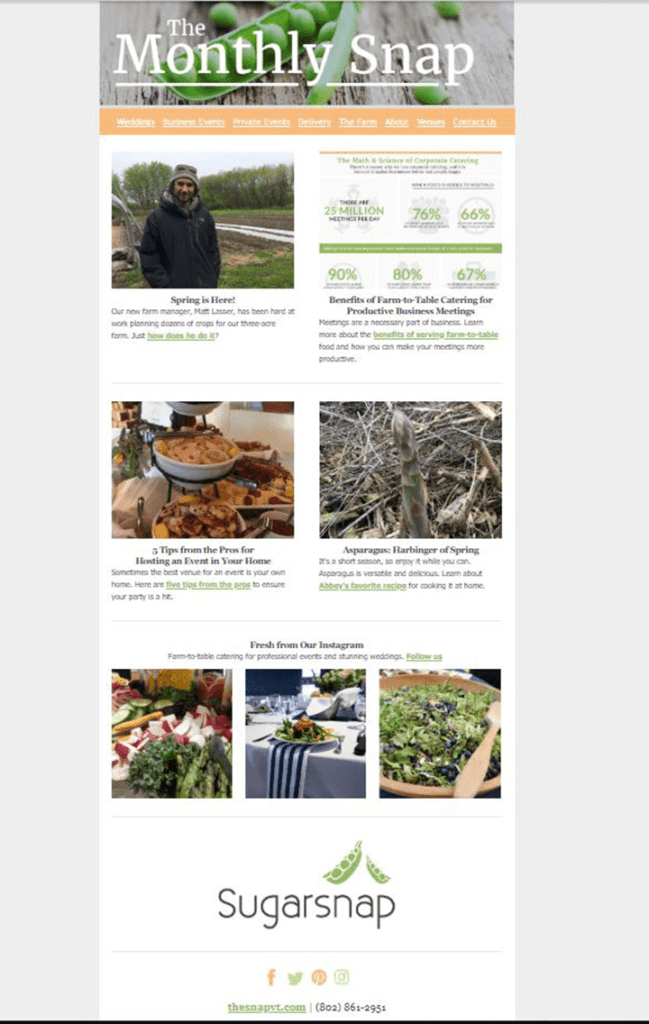
It contains links to their various blog posts, their Instagram page, and contact information.
And she also uses it to send her existing customers to her online menu on HoneyCart where they can conveniently order food. This process makes her stand toe-to-toe with her competitors.
According to Abbey:
“It (HoneyCart) automates mundane tasks to allow us to use our time as efficiently as possible. HoneyCart truly enables small caterers to compete with larger companies by having a really professional and easy-to-use online ordering system.”
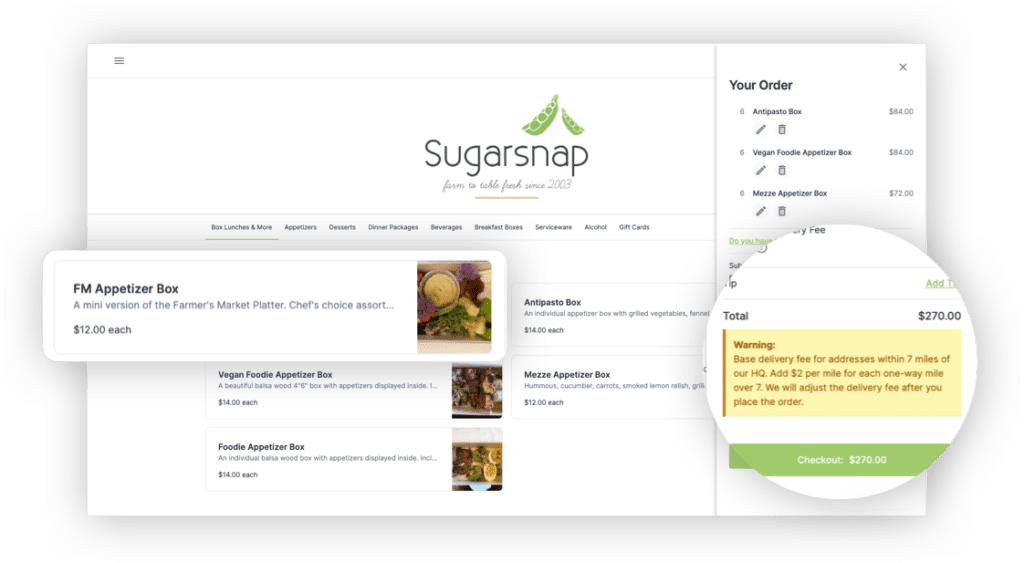
4. Partnership with Social Media Influencers
Ever heard of the word influencers? I bet you even follow some of them.
These are people with huge followers on social media. And they leverage it by partnering with brands to post sponsored content for them in exchange for financial gains.
Many brands are now investing their marketing budget into influencers. In fact, the global influencer market is set to grow to $22.3 billion by 2024.
The catering industry is no different.
When Gathering Moore, Marketing Manager at Ocean Prime Restaurant was asked why they added influencers to their marketing strategy, here’s what she said:
We believe there’s value in how our guests interpret what others say about their experiences at our restaurants. Influencers have evolved into a version of modern-day [food] critics, and our guests trust what they say.
And when it comes to people trusting influencers, I couldn’t agree more.
According to HubSpot, 71% of consumers are likely to buy products or services based on social media referrals or in this case influencers who they know, like and trust.
Influencers in the food and catering industry know how to steer the emotions of their audience with mouth-watering visuals, a sense of authenticity, and a close-knit community.
Now, I bet the question on your mind is how do you get influencers to market your catering business?
Simple!
You can reach out to individuals who have a sizable number of followers with lots of engagement on your preferred social media platform.
Then ask them if they would be interested in posting about your catering services. You can offer free food to them or pay an agreed amount for sponsored content.
However, macro-influencers – those who have millions of followers may be above your marketing budget. They are usually contacted by big brands with deep pockets that target all kinds of consumers.
To get the best results with influencers, it’s best to use micro-influencers – those with smaller followers but a very targeted audience.
For example, if you are a wedding caterer, you can reach out to influencers who post about weddings, relationships, marriage, family, and other related niches. You get the idea right?
Great!
There’s no doubt; using influencers to promote your catering services helps you get more eyes to your business, more followers, and ultimately more sales.
Conclusion: Catering Software Key to Selling Catering Services
If you are just starting your catering business, most of your orders will come from family, friends, colleagues, and referrals.
However, for you to grow your catering business, then you must be ready to market and sell. That is, sell your catering services to potential clients with the hope of turning them into loyal customers.
And while social gatherings and networking events may be unavailable for now due to the present economic situation, there are still other effective methods for selling your catering services.
You can run social media ads to create brand awareness, Google Ads for people already searching, email marketing to nurture potential clients, and partner with influencers to reach new audiences.
But how do you ensure your cateting clients remain loyal and even refer others to your services?
That’s where catering software like HoneyCart comes in.
HoneyCart makes it easy for your customers to place orders without the need for human staff.
It also helps you as a drop-off caterer streamline operations, process orders faster and generate more revenue for your catering business.
The best part? You don’t have to sacrifice commissions to third-party sites. You get to keep all your profits.
Just as Linda Estrada of MyTacoguy found out when she started using HoneyCart.
In her words:
“Now I’m spending less time processing orders, and customers love how easy it is to place an order. No more back and forth via email. They simply go to our website, browse the menu and place their order– I receive, confirm and print. DONE!
I love how I can make instant changes and updates to my menus without having to email someone to do it and waiting for days. I’m 100% in charge of my menu, my prices, and order volume. ”
Ready to sell your catering services with HoneyCart software? Start your free trial right away.
Oh! About Sarah, she eventually learned how to sell her catering services and now, she has more than 12 branches across three states.
Be like Sarah!

